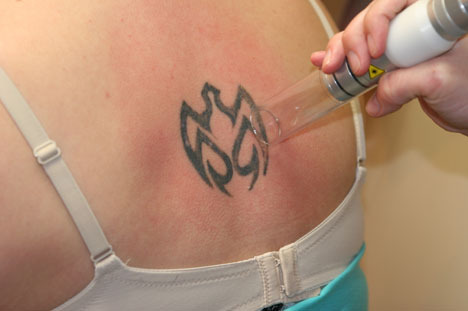How Laser Tattoo Removal Works
Unlike what some people imagine with laser tattoo removals and the myth of the skin being burned, it is actually a simple process of the laser making short pulses of intense light which passes through the top layers of the skin. This passing is basically absorbed by the tattoo pigments. The energy fragments the pigments into small pieces, which are later, naturally removed by the body’s immune system. Intense research in laser tattoo removing has been done to find the ideal frequency to remove the skin’s pigments, so that the original pigment of the skin will remain unaffected.
Usually the black pigments within the tattoo are removed first because black is a color that tends to absorb all types of laser wavelengths. The other colors only absorb a certain type of wavelengths, and thus, specific types of wavelength must be input to get rid of those colors. To successfully “force” the pigments to absorb the wavelengths, the doctors will also request the patient to take non-aspirin painkiller to reduce any uncomfortable circumstances such as headaches and partial pains. Some patients might also be recommended to put anesthetic cream about 120 minutes prior to the operation.
After the surgery is over, which is usually in minutes, the doctor will apply an antibacterial ointment, along with a dressing on the treated area. This area should be kept clean. A shower or a bath should only be done 24 hours after the surgery. After a certain time period, the tattoo should fade and eventually disappear.
Effects of Laser Tattoo Removing
The downside with tattoos is that it hurts when you’re getting them and when you’re removing them. According to numerous testimonials, using the laser to remove tattoos feels similar to getting hot drops of bacon grease on your skin or getting a snap by a thin rubber band.
Also, as with all laser surgeries, a laser tattoo removal can also result in hyper pigmentation, which is when the skin gets darker. On the other hand, equally, hypo pigmentation, when the skin gets whiter, can also occur. Not to forget, infections, an incomplete removal of the pigments, and even possibly permanent scars are always possible.


Comments - No Responses to “How Laser Tattoo Removal Works”
Sorry but comments are closed at this time.